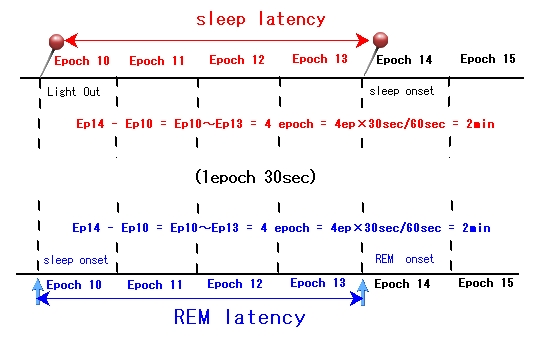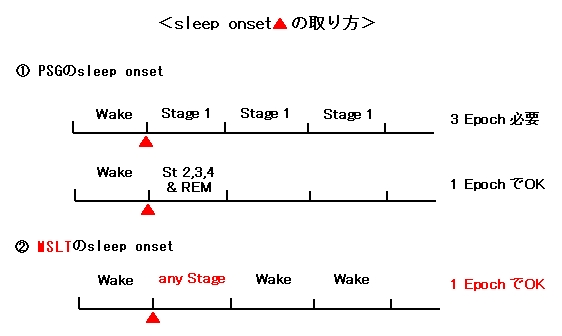Narcolepsyについて
・Onset is often in the second decade of life 発症年齢は10才代
・many are familial ; associated with human leukocyte antigen(HLA) DR2and HLA DQ1
・DQB1*1501(以前DR2と言われていたもの)・・・with Cataplexyの日本人のナルコレプシーでは95~100%陽 性。
・DQB1*0602(以前DQ1と言われていたもの) is a more sensitive marker = 人種差を超えてより強く関連するが、健 常者の8~15%で陽性であるので直ちにナルコレプシーとは言えない。また、ナルコレプシー患者さんの1-5%は陰性。
・EDS is usually the first symptom , followed months to years later by cataplexy, sleep paralysis and
hypnagogic hallucinations(narcolepsy without cataplexy).
・日本に多い 1人/600人<-->欧米は 1人/2000人
・家族内発症はみられるが頻度は低い。
Narcolepsy
Tetradについて
1.
Excessive daytime somnolence (EDS) = abrupt and unexpected "sleep attack" 普通では考え
られない状況でも突然眠ってしまう "睡眠発作"=眠気を感じる前に眠ってしまう=いつの間にか寝ている
・due to pathology of central nerverous system sleep-wake apparatus as seen in idiopathic hypersomnia,
posttraumatic hypersomnia and recurrent hypersomnia
・brief naps lasting 10 to 20 min occur repeadly throughout the day短時間(10~20分)の眠りの反復
・transiently relieved by a brief nap only to gradually increase again within two to three hrs.
覚醒時爽快感があるが、2~3時間で又眠る。
・OSASやPLMDは合併しててもよい。
40% of narcolepsy-cataplexy cases have PLMS(Narcolepsy, Hypocretin/Dopamine abnormality and
PLMS)
・REM睡眠から入る=SOREMP
2. Hypnagogic
hallucinations(入眠時幻覚wake to sleep=at sleep
onset )=寝入りばなの生々しい悪夢体験
(注)Hypnopompic hallucination(on
awakening=覚醒時幻覚)はTetradには入らない
3. REM(睡眠)関連症状(sleep paralysis/hypnagogic hallucination/cataplexy≒SOREMPs
≒neurochemistry的にはコリン系のhyperactivity, ノルアドレナリン系のhypoactivityは異常REMの発現
に関連する。
4. "cataplexy"is the most valuable symptom in diagnosing narcolepsy since normal individuals may
occasionally experience sleep paralysis and/or hypnagogic hallucination.
睡眠麻痺(いわゆる "金縛り" ) と入眠時幻覚は健常者でもしばしば体験する。
・"cataplexy":強い情動(喜びや笑い)が引き金となって突然起る両側性の筋緊張の喪失。"これ"あってこそ
のナルコレプシー。頬の筋肉がゆるむ,顎が落ちる,頭が垂れ下がる,舌が回らなくなる,手に持っていたコッ
プを落とす,膝ががくんとなる, 等程度は様々だが,持続は短く(数秒から数分以内)速やかに回復するのが 特徴。また,情動脱力発作中の意 識はclearである。
・cataplexyはspecificだが、present in only 70% of patients.
・respiratory muscles呼吸筋はnever affected。consciousnessも保たれる。
・undetectable hypocretin(= orexin:Greek for "appetite"食欲増進作用) in CSF(cerebrospinal fluid)
↓
hypocretin-secreting cellsはhypothalamusに存在する。
5. 夜間の熟睡障害・・・中途覚醒や夢と現実が混じり合った浅眠の持続.。
6. ナルコレプシーの2つの基本障害;
①睡眠覚醒リズムの障害→睡眠の多相化=単相性睡眠(睡眠パターンは,幼児期は多相性だが,成長と
共に単相化する=夜1回だけの睡眠で昼寝は必要ない)の分断化=ウルトラディアンリズム(超日リズム)
(=2時間毎に眠くなる)が顕在化するため,日中の反復する居眠りや夜間の中途覚醒が生じる。
⇔1日を単位とする概日リズムは,ナルコレプシーでも保持される。
②レム睡眠の障害→・レム睡眠関連症状が意識水準と解離して(覚醒中や半覚醒中に)生じる。
・覚醒⇔レム睡眠に相方向に移行しやすい(正常ではノンレムの後に出現)=レム睡眠発現様式の異常
Narcolepsyの治療
1. sleep attackに対しては、中枢刺激薬stimulantsのメチルフェニレートmethylphenidate(リタリン)や、
pemoline(ベタナミン) → 60~80% 有効 ⇒2007.6月からmodafinilモディオダールの使用OK。
・モディオダールは,主にヒスタミン覚醒系に作用(一部はドーパミン系にも作用)するので,リタリン(主にドー
パミン系に作用)よりも,幻覚,妄想,うつ病などの副作用が少ない。
※モディオダールは一部, リタリンは主としてドーパミン系に作用するので,<精神病,精神病の素因のある人や
うつ病の人には使用しない>方が良い。
・モディオダールは,突然中止してもreboundがない。
2. REM関連症状(sleep paralysis/hypnagogic hallucination/cataplexy)の治療:
三環系抗うつ薬tricyclic antidepressant(imipramineトフラニール、clomipramineアナフラニール=monoamine
reuptake inhibitorで治療する。second choice:三環系抗うつ薬の副作用強ければ,効果は落ちるがSSRI(パキシ
ル10mg OR ルボックス25mg眠前1回)も有効。
・三環系抗うつ薬の作用:
①特にノルアドレナリン↑が重要, serotonin↑, dopamine)&抗コリン作用によるREM睡眠抑制作用。
②催眠・鎮静=睡眠維持作用,睡眠深度維持作用
・ cataplexyの治療等のREM関連症状抑制目的の時は、三環系抗うつ薬は<少量>10~25mgで十分。これ
を眠前1回投与(∵朝に内服すると眠気↑や脱力感↑)。
効果は,その日から発現する(⇔抗うつ効果は1~2週かかる)。
漸増,漸減が使用の原則。トフラニールの場合,10mg→20→30mgまで。
突然の中止はcataplexyの重積状態を招く恐れがあるので注意。また,突然の中止により,離脱症状として,コリ
ン性の反跳現象(胃腸障害,めまい,気分不良,悪寒,鼻カタル,筋肉痛etc)が出ることがある。
・臨床的効果はトフラニール≒アナフラニール≒ノリトレン。
同じ三環系でもamitriptylineトリプタノールはREM睡眠抑制作用は強くない。
※コリン系はREM期に活動↑これをノルアドレナリンとセロトニンが抑制∴コリン系のhyperactivityやノルアド
レナリン系のhypoactivity=異常REMを発現 ⇒∴異常REMを抑制するには抗コリン&ノルアド↑
・三環系抗うつ薬の副作用:
anticholinergic(口渇,便秘、排尿困難、特に低血圧の人は起立性低血圧etc)&cardiovascular side
effects (e.g.,widened QRS, arrhythmias,特に心不全の人)。高齢者に出やすい=高齢者は,SSRIの方が安全。
・MAO阻害薬との併用は禁忌。⑥PSGではpseudospindle(14~18Hz)が出る。<->通常の
spindle(12~14Hz)
※ドーパミンは覚醒維持に関与∴ドーパミンのhypoactivity=眠気
MSLT
(Multiple Sleep Latency Test複数回睡眠潜時検査)について
・always必ずovernight PSG
の後に行う。=to rule out:movement disorders行動異常/sleep apnea/
insufficient sleep不眠/circadian rhythm disturbanceは、MSLTから除外=いつも寝てない人は
MSLTは必要ない。narcolepsyとmisdiagnoseしてしまう。
”Out-of-phase Sleep”(昼夜逆転)の人の場合は、その人の習慣に合わせて、夜MSLTをしたがよい。
Ask about ”sleep of previous
night and weeks” & use of drugs (sedatives/hypnotics/antihistamines
/amphetamines/tricyclic antidepressants)
・after overnight PSG, the technician is to remove the following:
leg EMG electrodes
respiratory belts
respiratory transducers
oximeter probe
・Montage
Two additional elecrodes (UE: Upper Eye & LE: Lower Eye) are applied above and below one of the
patient's eye and are referenced to an elecrode placed placed over the opposite mastoid(A1 or A2).
So montage should entail the following:
two EEG leads(a central and an occipital)
two referential leads(A1 and A2)
two to four EOG leads(ROC/A1, LOC/A2 and RUE/A1, RLE/A2)
three EMG leads(mental and two submental)
EKG leads
<methods>
・PSG終了後 90~120min 経ってから(average REM latency)MSLTを開始する。=
①REM睡眠中には起こ
さない(Nap #1でREM reboundを避ける為)。②final REM sleep中にarousalが起きた場合は、arousalの後
少なくとも3分後に"Light On"する。
・MSLTの部屋=静かで、暗い部屋で、airconで温度を保ち、時計は置かない。
・average REM latency は90~120min = 2hrs = MSLT での between naps
・between
napsでは、①食事はとって良い。②カフェインはダメ(∵sleep latencyおよびREM latencyを延す)。
③sugar,
stimulantはjust a little=not too much ならOK。④smokingはOKだが、次のnapの
15分前(or 30分前)にはstop。⑤exerciseもOKだが、次のnapの20分前にはstop。
⑥patient is to be out of bed and awake
------------------------------------------------------------------------------------------------
・4~5回の寝る機会napを与える。
①最初の4回のうち2回REM睡眠があればそれ以上する必要はない。
②if no sleep, run the nap for 20 minutes (or 40 epochs)=During each scheduled nap, the patient is
given 20 min after litht out to fall asleep. If sleep does not occur, then sleep latency is set at 20
min by conventions.
③if sleep, run the nap for 15 min (or 30 epochs) from the point of sleep onset=Once sleep is
attained, the patient is given another 15 min to attain REM sleep.
④if no REM sleep was attained, then REM latency is "None".
⑤shortest nap: 15 min; longest nap: 35 min
たとえば、
nap#1 9: 00 ・ if no sleepなら 9: 20 に検査終了(∵②)。このときのsleep latencyは 20 min。
・もし9: 07 に眠ったとしたら、 9: 07 + 15 min=9: 22 に終了(∵③)。このときのsleep latencyは7 min。
では次のnapの検査は?
nap#2 11: 00 (∵参照) ・Light Outの時点で既に眠っていたら 11: 15 に検査終了(∵③)。=shortest nap is 15
min(④)。このときのsleep latencyは0 min。
・Light Outの時点で既にREM sleepに入っていたら、このときのsleep latencyは0 min。
&このときのREM latencyは0 min。
nap#3は 13: 00 ・13: 01 にfell asleepして、13: 03にwoke upしたとする。このときのsleep latencyは1 min。
このときの検査終了時刻は13: 16(13: 01 + 15min)。
↓
1回寝た時間から15分が終了時刻 (∵③)(sleep onsetの定義)
nap#4は 15: 00 ・15: 20 にfell asleepに入ったとすると、このときの検査終了時刻は15: 35(15: 20 + 15min)
↓
35 min nap(=20min + 15min)
↓
This is the longest nap!(④)
nap#5は 17: 00 ・if 1 REM out of 4 naps, then do the fifth nap.
・if no sleepなら 9: 20 に検査終了。The patient had difficulty falling asleep in nap#5 because
he was "nervous and ready to go home"or 終わったらすぐ新幹線に乗らなければ、
="Last test"effect
------------------------------------------------------------------------------------------------
・<MSLTの目的>① sleep latencyをみる(to diagnose
EDS=short sleep latency=evidence of the
tendency to fall asleep during the day )
normal variation in sleep latency over the day:
shortest at noon and early afternoon naps (naps 3 or 4)
longest in the late afternoon
② SOREMPsの有無をみる(narcolepsyの診断)

・sleep latency(min) = L.O.(Light Out)
から until(=before) the first sleep onset epoch まで(sleep onset
(入眠 or 睡眠潜時) epochは含まない)
(SleepOnsetEpoch-LightOutEpoch)/2
(1epoch30secなら2epochが1min故、2で割る)。正常は30分以内。
ⅰ) patients with sleep-onset insomnia (difficulty in initiating sleep) typically have a
long sleep latency (more than 30 minutes)
ⅱ) earlier-than-normal bedtime during the sleep study can increase the sleep latency.
・REM latency(min) = the first sleep onset epoch から until(=before) the first REM epochまで
(レム睡眠潜時) ↓ (the first REM epochは含まない)
↓ (REM OnsetEpoch-SleepOnsetEpoch)/2
↓ normally 90(70)-120 minutes
たとえ途中にstage wakeが介在しても、あくまでthe first sleep epochから計算する。
たとえば、あるnapが下記のごとくであった場合のREM latencyは? W = stage wake
epoch 160 161 162 163 164 165 166 167 168 169 170 171 172 173 174 175 176 177 178 179 180
stage LO W W W W W 1 1 W W 1 2 3 3 3 4 4 4 R R
↑ ↑
the first sleep epoch the first REM epoch
REM latency=(Ep.178-Ep.166)/2=6 min

・sleep onset = "defined as the first epoch of sleep"
MSLTの場合は any stage の one epoch sleep でOK ( stageは問わない )
v.s.
PSGの場合は Stage1なら連続してconsecutive 3 epoch
必要(Stage2,3,4とstageREM
=REM sleepは1epochでOK)
・standard epoch length= R&Kの定義で 1
page 30cm (paper speed10mm/secなら30sec epoch
or 15mm/secなら20sec epoch)
・REM cycles are calculated from the end of one REM period to the beginning of the next
SOREMPs = Sleep-Onset REM Periods (a very short REM latency=15 minutes or less)
★neither specific for nor always present in narcolepsy
any REM episode occuring
within the first 15 minutes of sleep ( sleep onset から
最初の15分以内(REM latency is 15 minutes or less)にNREMから入らずに直接REMに入る )
・①narcolepsyの他、②newborn infants ( "active sleep in newborns"
)、
③depression or schizophrenics、④drug withdrawal ⑤deprivation of a given
sleep stageなどで見られる。
↓
REMを抑える薬REM suppressors(barbitulates/opiates/antidepressants/alcohol)は、
MSLT開始前の最低2週間は中止しておく。
・<medications affecting sleep architecture 薬物と睡眠構築障害>
↓normal sleep
Age 20 = stage1(5% of sleep), st2(45%), SWS(25%), REM(25%)
Age 50-60 = stage1(↑), st2(↑), SWS(↓to 0), REM(25%):SWS are age-dependent
benzodiazepines:ⅰ) suppress(=decrease) SWS
(sleeping pills) ⅱ) no consistent effect on REM sleep ≧ mildly reduce(=decrease) REM sleep
ⅲ) increase in spindle density and/or ★pseudo-spindles(=drug spindles)
barbituratesにおいてもⅲ)の所見がみられる。
★15Hz(14-18 Hz)〔=slightly higher than typical spindles(12-14Hz characteristic
of stage 2 sleep)〕
↓results in
increased scored stage 2 sleep
★high density spindle activity in all stages of sleep (awake, NREM, REM sleep)
.= may appear immediately at sleep onset and may persist into REM sleep
↓ ↓
∴confusing when differentiating sleep stages "Atypical REM Sleep"と言う
To determine the transition from stage 1 to stage 2 relies on other information
(such as decrease in slow-rolling eye movements, or the presence of K-complexes)
★ubiqutous sleep spindles(spindlesが至る所にある場合=数が極端に多い)は、
drug spindlesを疑う。⇔ 通常のspindlesはoccur in short bursts
<decrease REM sleep
=REM suppressors>
= long REM latency
|
<increase REM sleep> |
<no change in REM sleep> |
ethanol
tricyclic antidepressants(TCAs)▲
selective serotonin reuptake inhibitors(SSRI)
(パキシル、ルボックス)▲♪
MAO inhibitors(MAOIs) (the most potent suppressor of REM sleep)▲
lithium(リーマス)
amphetamines
methylphenidate(リタリン精神刺激薬)
clonidine(カタプレス降圧薬、中枢性α2アゴニスト)
benzodiazepines (mildly decrease)
|
nefazodone (in deprssed patients) bupropion (in deprssed patients)
reserpine
withdrawal of REM suppressors ◆ |
mirtazapine*
trazodone*(デジレル、レスリン) |
<decrease SWS > |
| benzodiazepines |
SWS = slow wave sleep * = Some studies show decreased REM sleep
・Virtually all antidepressants decrease REM sleep--except for nefazodone, bupropion, and possibly mirtazapine and trazodone--.
・Abrupt withdrawal of medications decreasing a given sleep stage or prior deprivation of a given
sleep stage can cause a rebound of that sleep stage when natural sleep is resumed.
So prior sleep deprivation can cause a rebound of SWS and REM sleep.
◆withdrawal of REM suppressorsで "REM sleep without motor inhibition"= RBDのPSG所見!=
secondary RBD ↓
↓
= "REM sleep without muscle atonia"
= "RWA (REM sleep without atonia)" とも言う。
a increased level of motor activity during REM sleep
▲ certain compounds of TCAs, MAOIs and SSRIの投与ででも起る。
=secondary RBD
♪when taking SSRI antidepressants, both slow and rapid eye movements may be prominent during stage2, 3, and 4
NREM sleep.
slow (rolling) eye movements (SEM):①characteristic of eyesclosed drowsy walefullness(α activity are noted) and
stage 1(α activity in less than 50% of the epochになるとsleep=stage 1と判定)。
②may follow an arousal and after a shift to a lighter stage of sleep。
③usually abscent during stage 2, 3, and 4 NREM sleep.
However slow wave activity usually noted in the eye movements channels。
rapid eye movements (REM):①stage wake(eys open and eye blink) (chin EMG amplitude is not reduced)
②stage REM
・<common factors altering REM latency レム睡眠潜時>
<short or decrease REM latency> |
<long or increase REM latency>
|
<no change in REM latency> |
narcolepsy
prior REM deprivation(→REM rebound)
obstructive sleep apnea(OSA)*
depression†(modest shortening <60min), schizophrenia
abrupt withdrawal of REM suppressors
later-than-normal bedtime
bupropion (in depressed patient)
|
first night effect
medical desease (COPD, chronic pain syndromes)
ethanol
REM suppressors:
tricyclic antidepressants (TCAs)
SSRIs(e.g., paroxetineパキシル, fluoxetine,
sertaline, citalopram)
MAO inhibitors (most)
trazodone(デジレル、レスリン)
venlafaxine(antidipressant)
stimulant medications (e.g., methylphenidateリタ
リ ン、amphetamine)
clonidine(カタプレス)
|
mirtazapine
nefazodone |
* any cause of REM sleep deprivation (e.g., OSA) may be associated with a short REM latency.
†<うつ病depressionと睡眠障害>
①「レム睡眠のパターン」はdepressionではREM sleepの長さdurationは、だんだん短くなる= "reverse pattern"
⇔正常ではだんだん長くなる。②majer causes of "early morning awakening(早朝覚醒)"are depression & ASPS
(Advanced sleep-phase syndrome) ↓
"予定時刻の2時間以上前に目覚める"
うつ病のPSG所見(P136 表4より引用、一部改変 一般医のための睡眠臨床ガイドブック 医学書院)
| REM 睡眠の異常 |
①short REM latency ②第1REM 睡眠持続時間の延長 ③第1REM 睡眠密度の増加
④睡眠後半のREM 睡眠の増加 |
| NREM 睡眠の異常 |
①SWS(stage 3, 4)の減少 ②stage 1の増加 ③第1NREM 睡眠でのδ波の減少
④第1NREM 睡眠よりも第2NREM 睡眠でδ波優位 |
| 睡眠持続時間の異常 |
①increased sleep latency ②中途覚醒の増加 ③早朝覚醒の増加 ④睡眠効率の低下 |
<idiopathic hypersomnnia(IHS)特発性過眠症>
・Mean sleep latency5~10min or/and one
SOREM = "idiopathic
hypersomnnia"
EDS despite adequate sleep
long (>8 hours) nocturnal sleep
long daytime naps・・・一旦眠り込むと目覚めるまで1時間以上と長時間を要する。
⇔ narcolepsyは10~20minの短時間
Unlike narcolepsy, naps are not refleshing 覚醒時爽快感を欠く
| |
NARCOLEPSY |
IHS |
| Symptoms |
Cataplexy in 70%
Hypnagogic halluciations
Sleep paralysis |
No Cataplexy
Hypnagogic halluciations
Sleep paralysis |
| 昼間の居眠り |
少しの刺激で容易に覚醒(∵レム睡眠のエピソード)
耐え難い眠気で,実際に眠ってしまう
睡眠発作もある
30分以内(5~20分程度)
Refreshing naps覚醒時爽快感(+)
2~3時間後に再び強い眠気が反復 |
覚醒させるのは困難(∵ノンレム睡眠のエピソード)
何とか実際に眠ってしまうのは我慢できる程度
1時間以上(3~4時間に及ぶ)
Non-refreshing naps覚醒時爽快感(-)で寝ぼけが続くこともある(睡眠酩酊とも呼ばれる) |
| Nocturnal sleep (夜間睡眠) |
Fragmented sleep中途覚醒による睡眠の分断
入眠時レム(SOREMPs)
Short sleep latency
Short REM latency
目覚めは良い |
No fragmented sleep夜間睡眠の分断は認めない
=質的には正常
Normal to long total sleep time夜間総睡眠時間は正常か延長する。
Normal sleep architecture
REM latency not decreased
起床に大きな努力を要する |
| 睡眠関連の合併症 |
PLMD(周期性四肢運動障害)合併も多い |
総睡眠時間の延長(14-5時間に及ぶこともある) |
| 合併症 |
肥満やⅡ型糖尿病の頻度が高い |
自律神経症状(頭痛,起立性低血圧,めまい,四肢冷感)の頻度が高い |
| MSLT |
Mean sleep latency 5min or less
and SOREMPs≧2 in 5 naps
|
Mean sleep latency 5~10min
with one or no SOREMPs
|
(P28 表2より一部引用、第二回睡眠医療・生涯教育セミナー・テキスト 日本睡眠学会編)
・"first night effect"= an example of the "adjustment sleep disorder"
↓
= "transient psychophysiologic insomnia"
(usually less than 6 months)
↓
defined as insomnia related to an acute stress, conflict, or environmental change.
Rather than a true disorder, it is a normal reaction to one of life's many stresses.
睡眠環境が変わるため、many normal peopleは
①初回検査の時はREMに入りにくい=increased REM latency
②初回検査の時はsleepに入りにくい=increased sleep latency
逆に、psychophysiologic insomniaの人は、新しい環境での方
がよく眠れる。

|